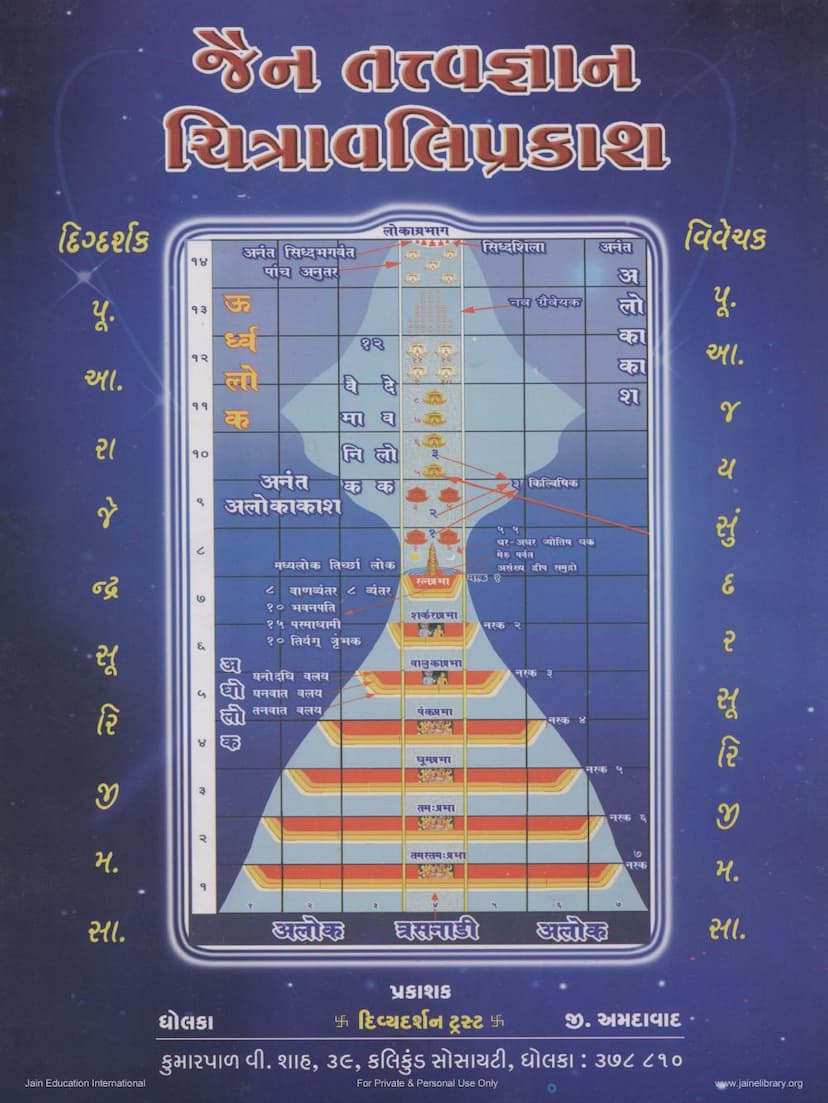Jain Tattvagyan Chitravali Prakash
Added to library: September 2, 2025

Summary
This Jain text, "Jain Tattvagyan Chitravali Prakash" by Bhuvanbhanusuri, published by Divya Darshan Trust, is a comprehensive illustrated guide to Jain philosophy and cosmology. The book aims to provide a clear and accessible understanding of Jain principles, particularly for younger generations and seekers of knowledge.
Key themes and content covered:
-
Jain Cosmology and Geography: The book illustrates and explains the Jain universe, including the fourteen rajlokas (regions of the universe), the alokakasha (non-living space beyond the universe), and the intricate structure of the Middle Realm (madhyalok), Lower Realm (adholog), and Upper Realm (urdhvalok). It details the various heavenly abodes of gods (devalokas), the locations of different celestial beings (vanavyantar, vyantar, bhavanapati, jyotishchakra), the structure of the earth with its continents and oceans (like Jambudvipa and Lavana Samudra), the Meru mountain, and the different hellish realms (naraka).
-
Core Jain Principles (Navatattva): The text explains the fundamental Jain principles, likely encompassing the nine tattvas (realities):
- Jiva (Soul): The eternal, conscious essence of living beings, its nature, and its journey through various states.
- Ajiva (Non-soul): The non-living substances of the universe.
- Punya (Merit): Actions leading to positive outcomes and happiness.
- Papa (Demerit): Actions leading to negative outcomes and suffering.
- Asrava (Influx): The inflow of karmic particles into the soul.
- Samvara (Stoppage): The halting of karmic influx through self-control and adherence to vows.
- Bandha (Bondage): The actual binding of karmic particles to the soul.
- Nirjara (Shedding of Karma): The process of purging accumulated karma through penance and austerities.
- Moksha (Liberation): The ultimate state of freedom from the cycle of birth and death. The book uses allegories like a boat on a lake to explain these principles, illustrating how soul (boat) is bound by karma (water entering the boat through holes) and how liberation is achieved by stopping the influx (Samvara) and purging the karma (Nirjara).
-
The Soul's Journey (Development): The book traces the spiritual evolution of the soul, starting from the most rudimentary state of existence in nigoda (a state of extreme suffering for single-sensed beings) and progressing through various stages of spiritual development towards liberation. It discusses the stages of spiritual progress (gunasthanas).
-
Karma Theory: It elaborates on the eight types of karma (ashtakarma) that bind the soul, their nature, their effects on the soul's qualities (like knowledge, perception, happiness), and the processes involved in their bondage and shedding. The text details how karma obscures the soul's pure nature and leads to its embodiment in different forms and states of suffering.
-
The Six Essential Substances (Dravya): The book likely explains the six fundamental substances in Jainism: Jiva (soul), Pudgala (matter), Dharma (principle of motion), Adharma (principle of rest), Akasha (space), and Kala (time), their characteristics, and their role in the universe.
-
The Cycle of Time (Kalchakra): It explains the concept of time cycles, the ascending (utsarpini) and descending (avasarpini) eras, and the gradual changes in the lifespan, physical form, and spiritual development of beings during these cycles.
-
The Living Beings (Jiva): It provides a detailed classification of living beings, categorizing them into one-sensed (ekendriya), two-sensed (dvi-indriya), three-sensed (tri-indriya), four-sensed (chatur-indriya), and five-sensed (panchendriya) beings. It further breaks down these categories into sthavara (immobile) and trasa (mobile) souls, and describes their respective life forms, habitats, and karmic implications. The text identifies 563 types of living beings across the four life-streams (hellish beings, animals, humans, and gods).
-
Conduct and Ethics: The book emphasizes the importance of right faith (samyak-darshan), right knowledge (samyak-gyan), and right conduct (samyak-charitra) for spiritual progress. It highlights ethical principles such as non-violence (ahimsa), truthfulness (satya), non-stealing (asteya), celibacy (brahmacharya), and non-possession (aparigraha), as well as the classification of edible and non-edible substances (bhakshya-abhakshya) and their impact on spiritual purity.
-
Spiritual Development and Liberation: The ultimate goal of Jainism, liberation (moksha), is explained as the attainment of the soul's pristine, omniscient, and blissful state by eradicating all karmic coverings. The book likely outlines the path to liberation through the practice of the three jewels and the twelve vows.
-
Illustrations and Diagrams: The title "Chitravali" signifies that the book is rich with illustrations and diagrams, which are crucial for visually representing complex concepts like the structure of the universe, the states of the soul, and the progression through spiritual stages.
-
Commentary and Guidance: The book is dedicated to revered spiritual masters, indicating a scholarly approach and providing commentary on Jain scriptures. The author, Acharya Shrimad Vijay Bhuvanbhanusurishwarji Maharaj, and the reviewers, Acharya Shri Rajendrasuriji M.Sa. and Acharya Shri Jayasundarsuri M.Sa., suggest that the content is authentic and authoritative.
In essence, "Jain Tattvagyan Chitravali Prakash" serves as a visual encyclopedia and a spiritual roadmap for understanding and practicing Jainism, covering its philosophical underpinnings, its cosmological framework, and the path to spiritual upliftment and ultimate liberation.